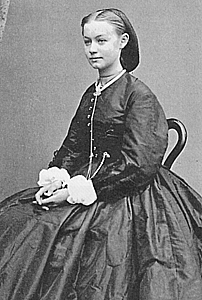Agathe Backer Grøndahl facts for kids
Agathe Ursula Backer Grøndahl (born December 1, 1847 – died June 4, 1907) was a talented Norwegian pianist and composer. She married a conductor and singing teacher named Olaus Andreas Grøndahl in 1875. After that, she was known as Agathe Backer Grøndahl. Her son, Fridtjof Backer-Grøndahl, also became a pianist and composer. He helped share his mother's music in his own concerts.
Biography
Agathe Ursula Backer was born in Holmestrand in 1847. Her family was wealthy and loved art. She was the second youngest of four sisters, and all of them were good at drawing and music. In 1857, her family moved to Christiania (which is now Oslo). There, she studied music with important teachers like Otto Winther-Hjelm, Halfdan Kjerulf, and Ludvig Mathias Lindeman.
Between 1865 and 1867, she studied with Theodor Kullak in Berlin. She also learned how to compose music from Richard Wuerst at the Akademie der Tonkunst. She lived in Berlin with her sister, Harriet Backer. Agathe became famous there for playing Beethoven's "Emperor" Concerto, a very difficult piano piece.
In 1868, she performed for the first time with Edvard Grieg, who was 26 years old at the time. He conducted the Philharmonic Society. A famous violinist, Ole Bull, suggested she study more. So, in 1871, she went to Florence to learn from Hans von Bülow. Later that year, she played in Leipzig. In 1873, she became a student of Franz Liszt in Weimar.
In 1875, she married Herr Grondahl, a well-known singing teacher in Christiania. In the late 1870s, she became a very successful pianist. She gave many concerts in Nordic countries, and also played with great success in London and Paris.

In 1889 and 1890, she performed in London and Birmingham. Her concerts included Grieg's famous piano concerto. After these performances, the famous writer George Bernard Shaw called her one of the greatest piano artists of her time. He also noted how sensitive and balanced her compositions were. At the World Exhibition in Paris in 1889, she again impressed everyone with her playing of Grieg's piano concerto.
Around this time, she started having nerve problems. However, she eventually returned to her music career. Later in the 1890s, she became almost completely deaf. She gave her last concerts in Sweden and Finland in the autumn of 1901. After that, she focused on teaching music.
Teaching style
Agathe Backer Grøndahl was a very successful and important teacher. Her own children studied with her. She wrote many songs and a lot of music for the piano. As both a pianist and a composer, she was a leader in modern Norwegian music. She passed away at her home in Ormøya, near Christiania, when she was 59 years old. Today, she is mostly remembered for her beautiful piano pieces and songs.
Compositional style
Agathe Backer Grøndahl played a big part in what is called the golden age of Norwegian music. She wrote about 400 pieces of music in total. She was a well-known person in the Norwegian music world and a close friend of Edvard Grieg.
Her early music combined the popular piano styles of Europe from the 1850s. But later in her life, her style changed. It started to show ideas from the early 1900s, like "impressionism." This led the composer Pauline Hall to call her the first true Norwegian impressionist composer.
List of works
Agathe Backer Grøndahl wrote many pieces. Here are some examples of her songs and piano music:
Songs
- 3 Songs, Op. 1 (1868–69)
- 5 Songs, Op. 2 (1871)
- Summer Life, 4 Songs, Op. 7
- Songs at Sea, Op. 17 (1884)
- The Child's Spring Day, song cycle, Op. 42 (1899)
- The Mother Sings, 8 songs, Op. 52 (1900)
Piano solo
- 6 concert-etudes, Op. 11 (1881)
- 3 morceaux, Op. 15 (1882)
- Suite, 5 movements Op. 20 (1887)
- 3 études, Op. 22 (1888)
- 6 idylles, Op. 24 (1888)
- Norske folkeviser og folkedanse, Op. 30 (1891)
- Fantasistykker, Op. 36 (1895)
- In the Blue Mountain, fairytale suite, 6 pieces, Op. 44 (1897)
- Etudes de concert, Op. 47 (Copenhagen, 1901)
- Barnlige Billeder [Children Pictures], 6 fantasias, Op. 66 (1905)
See also
 In Spanish: Agathe Backer Grøndahl para niños
In Spanish: Agathe Backer Grøndahl para niños


